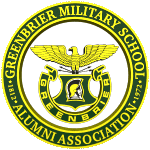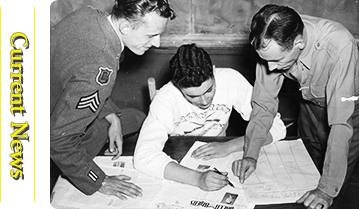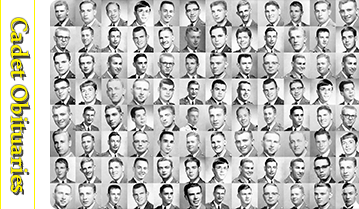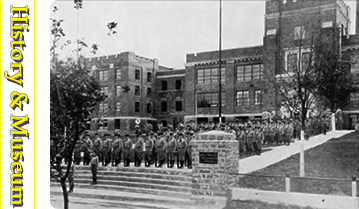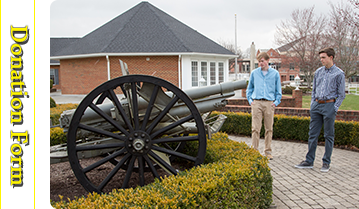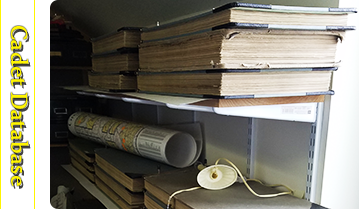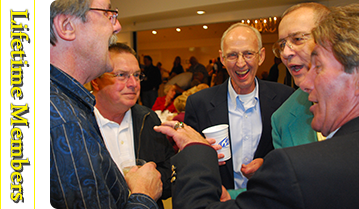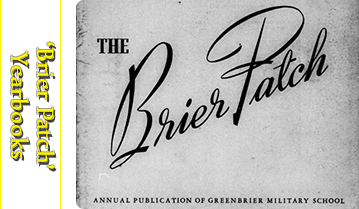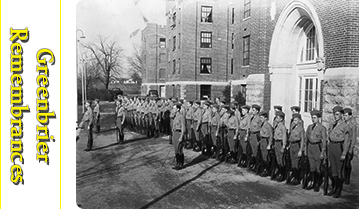
GREENBRIER MILITARY SCHOOL – 200 YEARS AND COUNTING
by
DEAK ROBERTS ’56
MARCH 2012
Preface:
Passing In Review articles are normally about one of our Alumni; however, this year, it is appropriate to present an article about our own Greenbrier Military School (GMS) itself and the Greenbrier Military School Alumni Association (GMSAA) since we are celebrating 200 Years of GMS evolution from Dr. McElhenny's grassroots class in the Old Stone Church to the closing of the military school and opening of the medical school to the development of the school's Alumni who carry forward the Greenbrier Spirit and have done, and continue to do, many things to enhance the legacies of GMS and serve notice that something important happened here and it continues.
Our celebration will take place during the annual GMSAA Reunion October 18 through 21, 2012, at the old school Alumni Center (now on the campus of the West Virginia School of Osteopathic Medicine (WVSOM) in Lewisburg (the only Medical School in the United States, and probably the World, with cannons on its campus), and in White Sulphur Springs, WV, at the world famous "The Greenbrier Hotel & Resort" which played a significant role in Greenbrier Military School history.
The cannons, of course, guard the entrance to our Alumni Center and Offices and our wonderful brick and mortar legacies, the Greenbrier Memorial Museum housing our memorabilia and artifacts, and the Memorial Plaza dedicated to our Alumni who have fallen in Wars.
In the beginning, the school's origination in 1812 was second only to the United States Military Academy at West Point, NY, started in 1802. In addition, GMS holds the distinction of being the oldest privately owned military school in the history of the United States. This article is dedicated to the school itself and those who made it possible to become one of the premier educational institutions in our nation's history, those who actually attended there as Cadets, and all those family members and friends who have been associated with the venerable school and its Alumni and are imbued with the "Greenbrier Spirit."




THE GREENBRIER SPIRIT
(Defined by Deak Roberts, Class of ’56)The "Greenbrier Spirit" exists in every Greenbrier Military School Alumnus and it somehow intangibly transfers to family and friends who are close to those who have the "Greenbrier Spirit". The "Greenbrier Spirit" is especially prevalent when former members of Greenbrier Military School are together or if one is in the presence of others that have the "Greenbrier Spirit."
The "Greenbrier Spirit" is difficult to describe in words, but it can best be thought of as that intangible feeling we have when in the presence and camaraderie of those who have experienced Greenbrier Military School, especially when in the proximity of the old school and grounds.
The "Greenbrier Spirit" feeling is based in having experienced the school and what the school was, what it stood for, and what it imparted to every Cadet there, an appreciation of Duty, Truth, and Honor; the skills of Leadership, the virtues of honesty, integrity, responsibility, morality, decency, respectability, ethical behavior, and the desire to achieve and succeed.
The "Greenbrier Spirit" is a Legacy of the Greenbrier Military School and is available to all those having an appreciation of Greenbrier Military School and its Alumni. To have the "Greenbrier Spirit" is to believe in the virtues and values infused into every former member of Greenbrier Military School, enthusiastically support the goals and objectives of the GMS Alumni Association, and its subsidiary, the Greenbrier Society, and accept and embrace the fact that the "Greenbrier Spirit" will spread to others you have contact with. May the "Spirit of Greenbrier" live Forever.
GREENBRIER FOREVER
End of Preface
GREENBRIER MILITARY SCHOOL – 200 YEARS AND COUNTING
by
DEAK ROBERTS ’56
GREENBRIER MILITARY SCHOOL (GMS) -- THE EARLY DAYS
IN the beginning, the school's origination was second only to the United States Military Academy at West Point, NY, started in 1802, and GMS holds the distinction of being the oldest privately owned military school in the history of the United States. The Historical Marker says "First school was established 1808-09 by Dr. John McElhenney and chartered as an academy in 1812. Used as barracks and hospital during War between the States. The present buildings were erected in 1921."
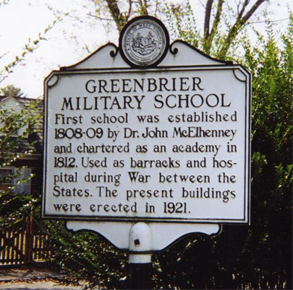
Although the evolution of GMS is sometimes disputed, it is generally believed it began from humble beginnings in Lewisburg, West Virginia, as the Brick Academy and later, the Lewisburg Academy in 1812, across Church Street from the historic Old Stone Presbyterian Church after receiving the official blessing of the Virginia Legislature to create an Academy. At the request of the citizens, the Old Stone Church Pastor, Dr. John McElhenney, started the original co-ed classical school which evolved to become Greenbrier Military School after the Civil War, and subsequent to the creation of a second school for girls which later became the Greenbrier College for Women (GCW). Students, male and female, came from throughout Virginia and other States. The school remained mostly co-ed until the Civil War. During the Civil War, the Academy buildings and the Church were used as winter barracks and a hospital for Confederate Soldiers.
After the Civil War, the future GCW became a separate entity because, it is said, the boys tired of competing with the girls who demonstrated greater academic ability. The girl's school was actually started before the boy's school after the Civil War. The boy's school, which became known as the Greenbrier Military Academy, prospered and grew in size and stature, attracting students from near and far. In the late 1800s, fire destroyed the school building and classes were carried on in a private residence. In 1896, a new building was built in a beautiful oak grove on the grounds of the Greenbrier Agricultural Society (old Fair Grounds) east of downtown. The school came under the control of the Greenbrier Presbytery who operated the school into the early 1900s. Bible studies became an important part of the instruction. In 1906, the school came under the direction of Colonel Houston B. Moore II, and in 1922, Col. Moore, along with his brothers, D.T. Moore and Joseph M. Moore, bought the school from the Presbytery, named it Greenbrier Military School and instituted Military Training. There was another fire that burned the building and in 1921, the Moore family built the building that still stands today.
It is interesting that the Greenbrier College for Women had its start from the same humble beginnings as the military school. It also had a number of fires along the way that destroyed the buildings, but they were always rebuilt. Like the Military School, it also served as a hospital and barracks during the Civil War. It had been called the Lewisburg Academy and the Lewisburg Female Institute before becoming the Greenbrier College for Women (GCW). GCW was extremely important in the history of GMS. Being located across town was a decent physical separation from the boy's school; however, that did not deter the boys from going there to visit the young ladies. There was also the cultural relationship between the schools. For instance, the schools maintained a combined vocal ensemble that was of the highest quality, and good enough to perform concerts, not only in Carnegie Hall on the GCW campus, but in other cities in West Virginia. They also shared the Old Stone Presbyterian Church on Sunday evenings when the Military School Battalion, in full dress uniforms, paraded across town, stopping traffic in all directions, and filed single file into the church balcony where we sang the old songs, quite loudly, and looked down on the girls from the College.
GREENBRIER MILITARY SCHOOL -- GROWTH, PROSPERITY, AND HAY•DAY
During the 30's, 40's, and 50's, under the direction of the Moore Family, the school continued to grow and prosper until it was offering a "boy's only" boarding school for Grades 7 through 12, with a vigorous Post Graduate program popular for athletes who were not quite ready for college, and two years of College. The school became Nationally recognized as one of the top 10 military schools in the nation. It had Army ROTC, with a retired Army Major as Professor of Military Science and Tactics (PMS&T), with active duty Army Officers and Enlisted personnel making up the Military Department, and the training there was equal to the first two years of College ROTC. If you had two or more years of ROTC at Greenbrier, you could be exempt from ROTC for your first two years of College.
It is believed the school and the Cadets of the 30s and 40s steadily built the reputation of the school and formed and consolidated the traditions, customs, and rules of the school, continuously building toward what is believed to be the Hay•Day in the 50s where the school was functioning at maximum capacity, maximum attendance, and operated like a well-oiled machine. Students came from many foreign countries and throughout the United States. There was a popular misconception that only boys that were incorrigible went to Military School. Nothing could have been further from the truth. Yes, there were a few incorrigibles, but most of the students came for the excellent college preparatory education coupled with the structured discipline and Principle-based Leadership education that would serve them well for the rest of their lives. The parents of the foreign students were looking for the best place in the country to send their sons, and GMS had several foreign students every year.
The environment at GMS was strictly military. Cadet Officers for the school were selected by the ROTC Military Department. The Battalion consisted of a Headquarters Staff (Battalion Commander, Rank: Cadet Major), his Adjutant (Rank: Cadet Captain), Sergeant-Major: (Rank: Command Sergeant Major - Highest Enlisted Cadet Rank) and Color-guard personnel. There was the Band Company, and Companies A,B, and C housed in the Quadrangle. Company D and Company E (7th & 8th graders known as "Peanuts") were housed clear at the other side of the school with the Peanuts residing above the "D" Company dorm.
Companies A through D were commanded by a Cadet Captain, and consisted of two Platoons commanded by a First Lieutenant or Second Lieutenant, and there was a Company First Sergeant. The Platoons consisted of three Squads who generally had Sergeants for Squad Leaders, and Corporals for Asst. Squad Leaders who marched at the end of the Squad. There was a Guidon Bearer in front of the Company, and a Company First Sergeant, and the Platoons had Platoon Sergeants. The Band had a Cadet Captain as Commander and an Executive Officer (First or Second Lieutenant), and a Drum Major.
It is interesting that there was seldom interaction between the Quadrangle Companies and Company "D". The Band did send a continent to the "D" Company dorm every morning to play Reveille to wake everyone up. It usually consisted of a snare drum, and a couple of very loud trumpets, a tuba, maybe a Clarinet or other horns. In the early 50's, there was one "D" Company Commander who played drums in the jazz band who would come out and join the band members for Reveille. They would swing up and down the corridor playing Dixieland Jazz as loudly as possible, and the sound reverberated in that corridor to make it even louder. Nobody slept through that. In fact, they were rather good at times and some would open their door to hear better. About the only other interaction between Company "D" and the others was Intramural Sports.
Company "D" was somewhat of an aberration. They truly were in their own world. Their showers were in the old Gym out back of the "D" Company wing, which often required dashing through the rain or trudging through snow and cold blowing winds to go there and back. Frequently, in winter, they would turn all the showers on "HOT ONLY" and create a steam room, a sauna of sorts, then take a quick shower and dash back through the snow to the dorm. There was always a Guard posted at the head of the corridor, but rumors had it that, on occasion, Cadets were known to slip out the windows, which were not far from the ground, and visit friends in town.
Competition, and striving for excellence, was very much a part of Greenbrier life. The greatest Honor was, at the end of the year, to be selected Honor Company, which meant you were the best for that year, and that Company carried that Honor throughout the following year. There was lots of competition. Every Parade was graded and a Winner was selected. There was competition for Best Cadet, Best Squad, Best Platoon, and, of course, Best Company. These were things you worked toward all year. There was competition in Sports, on the Rifle Range, and in the Classroom. They gave Medals and Trophies for being the best in just about everything.
Academics were second to none at Greenbrier. The school was primarily a college preparatory school. You could study the sciences and math, and business. Studying was a must and a Study Hall was provided nightly for those needing it. Everyone studied a couple of hours before bedtime every night. Guard duty personnel would peek through the window in the door to insure you were indeed studying. Study Hall was not the most popular place in the school, and getting out of it for even a little while was desired. Every ingenious excuse for a hall pass out of study hall was employed. "My roommate borrowed my book and I need it now." "I think I am going to have diarrhea and need to go now." "My Father asked me to call him in exactly 5 minutes from now." " I forgot my glasses in the drawer in my room." " I really don't feel well, and think I'm going to throw up." Most of the excuses did not work.
Life at the school was not easy from Day 1. New Cadets found out rather quickly they would get written up for infractions every time they turned around. Demerits had to be walked off on the infamous "The Beat". "The Beat" was the rectangular walkway around the flagpole in front of the school. Each demerit was worth a half hour on "The Beat". Most new students spent their share of Beat time on Saturdays while everyone else went into town to the movies or over to the girl's school. By the second half of their first year, the smart ones had learned to avoid "The Beat". Of course, there were those not-so-smart ones that continued to populate "The Beat", and some that became, more or less, permanent fixtures.
DUTY, TRUTH, AND HONOR
Everyone was expected to do his Duty. They had the moral and legal obligation to obey the Rules. Cadets were training to become Principle-based Leaders from the minute they set foot on the campus. They had classes in Bible and they were instructed to always do the honorable and ethical thing and tell the truth no matter what the consequences. There was an Honor Court that was composed of all the Cadet Officers. Serious infractions were brought before this Court for disposition. This was sixteen fellow senior Cadets sitting in judgment of other Cadets. Not only that, but anyone of higher rank could report someone of lower rank than they, and the Demerits would be handed out. You could earn Merits as well which would erase Demerits. Rules were taken very seriously and the Commandment was "thou shalt not commit an infraction of the Rules". Greenbrier Military School was a place of Honor. You were expected to Honor, and pay respect to, the Administrators and Instructors, and the Officers and those of higher rank than yourself. You were to address Officers by their rank or "Sir". You were to do what you were told to do. Discipline was being taught and enforced on a daily basis. Everyone was expected to abide by the Rules. If you did not, and got caught, you had to pay the price. The operative word was "caught". Boys, being boys, frequently did things that were contrary to the Rules, and very seldom did they get caught. There was the rumor going around that some boys on an upper stoop of the Quadrangle had urinated out the window onto a particular faculty member's car. Although the faculty member suspected who did it, it could not be proven, and the crime went unsolved.
The Head of the school in the 20th Century was always a member of the Moore family, and they were good Administrators with vast experience over the years of dealing with young men and the various situations. Greenbrier was not a school for everyone, and everyone did not remain there. Some were removed by the Administration, and some left of their own volition, but should not have. More than one had done this and later deeply regretted it. Then there was the story of the young man who was a junior and a Sergeant in his second year who decided he wanted to leave the school and return to his hometown high school where his girl was. Colonel Moore got wind of this (how is a mystery and it was always a mystery how Colonel Moore heard about things, but he did) and called the young man to his office. Normally, a call to go to Colonel Moore's office was not good news. Col. Moore was very gracious and asked the young man if the rumor was true. The young man said it was. Col. Moore had the young man's record in front of him, and he explained to the young man that it would be a mistake to leave Greenbrier now, that the young man was doing very well in the eyes of his instructors, the Military Department, and the Administration. Col. Moore advised the young man he had spoken with his Father and that his Father wished to talk with the young man as soon as possible. The Father was a salesman on the road, and Col. Moore had actually tracked him down and found him in Chicago. Col. Moore asked his Secretary to make the call and handed the phone to the young man. The Father advised the young man he agreed with Col. Moore and explained the family had made a substantial investment in sending the young man to Greenbrier where he could get a first class education that would prepare him for college and to sacrifice that to go home would not be the right thing to do, nor would it be in the young man's interest. The young man had great respect for his Father and Col. Moore, and he agreed to stay at Greenbrier, and he continued to do well. When the young man returned to Greenbrier the following senior year, he was surprised to learn he had been selected to be one of the school's sixteen Cadet Officers. Greenbrier had taught him another lesson in Leadership. Subordinates sometimes make wrong choices, but the counsel of his experienced leader can often set him on the right path.
DECLINE AND THE QUIET CLOSING OF THE DOORS
The 1960s were turbulent to say the least. The Cuban Missile Crisis in October 1962, brought the world to the brink of nuclear disaster. President Kennedy, Bobby Kennedy, and Martin Luther King were assassinated. Many countries in Africa became independent from their colonial rulers. The Russians put Sputnik in orbit and the Space Race was on. We put men on the Moon. The War in Viet Nam was becoming increasingly unpopular. There was the Cultural Revolution in China. Troubles occurred in Northern Ireland, and student uprisings broke out in Europe. The Civil Rights Act ended segregation in schools and public places in the United States. We found that throughout the 60s, as the War in Viet Nam escalated, all things military including military schools declined in popularity and enrollments declined measurably. Many military schools went out of business. Adding to this was the fact that GMS owners had been the Moore family for so many years, but attrition within the family brought the day when there were no family members left to run the school.
So, in 1972, the decision to close was executed and Greenbrier Military School graduated its last class and Taps played at Retreat for the last time as the doors swung closed marking the end of 160 Years of graduating thousands of Leaders for our Nation, many of which had distinguished careers in their field of endeavor. There were Industrial Giants, Inventors and Entrepreneurs, Congressmen and Governors, Army, Marine Corps, and Air Force Colonels and Generals, Navy Captains and Admirals, Ministers of the Gospel, and leaders that would serve in every corner of our nation. This was the end of one of our nation's finest educational institutions producing Principle-based Leaders for all walks of life. The old school was sold to a group of Physicians who started the Greenbrier College of Osteopathic Medicine which later became part of the State of West Virginia higher education system and became the West Virginia School of Osteopathic Medicine (WVSOM) to provide physicians for rural West Virginia. The school would become one of the finest medical schools in the nation and is believed to be the only medical school in the world with canons on its campus.
The Greenbrier Military School Alumni Association
Truth • Duty • Honor
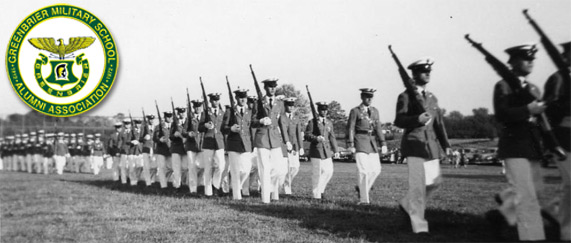
After the school ceased to be operational, the Greenbrier Military School Alumni Association (GMSAA) continued to foster the legacies of GMS from their offices on the WVSOM campus by first building the Greenbrier Memorial Museum and Memorial Plaza. The Museum and GMSAA Offices now rest on the site of the old tennis courts that were back of the parade ground. Provision has been made to see that our brick and mortar legacy will continue on in perpetuity after we are all gone. Today, the GMSAA is a strong and active organization that was directed by a 20 Member Board of Directors that just last year was reduced to a 16 member Board. This Board directs all activities of the GMSAA and oversees the activities of our subsidiary organization, the Greenbrier Forever Society (GFS) which consists of the families and friends of GMS and of the GMSAA, and the new Greenbrier Leadership Institute (GLI). The Board has a President, Vice President (who will become the next President), a Secretary, and a Treasurer. There is also a Quartermaster who tends the organization's store, and a Public Affairs Officer who maintains a staff of advisors, and communicates with the Media. It also has Committees. Currently, those Committees are Memorabilia, Greenbrier Forever (Fund Raising), Leadership, 2012 (200th Anniversary), and Website/Computer. There is also the new Greenbrier Leadership Institute (GLI), a permanent institution within the GMSAA.
The newly created GLI has a Director and Staff responsible for development and implementation of a Principle-based Leadership Education Program for High School students who desire to become Leaders. This is an attempt to provide these students with the same type of leadership education we received at GMS. As of now, they have been conducting an extremely successful face to face program with students from the local Greenbrier County East and West High Schools for the past four years. There are plans to expand the Program to other Counties, and, eventually, beyond. We desire to reach as many students as possible throughout the nation who desire to become Leaders. This will probably require offering some or all of our education program on-line. It is believed our Leadership Education Program should be our greatest legacy.
The GMSAA Secretary publishes the magnificent Alumni Record twice a year. This substantial publication contains all the news, photos and information for the membership. It contains special articles under "Reflections" and "Passing In Review", and "the Last Word", and usually, there are a few words from our President. This wonderful publication is mailed to every member of the GMSAA and GFS.
Four-Day Reunions are held annually in the Alumni Center on the old campus in mid-October when the West Virginia Mountains are beautifully covered with colorful leaves in shades of red and gold producing breathtaking scenery of such magnificence as to have no rival anywhere on earth. The reunions run from the Flag Raising and Board Meeting starting at noon Thursday through Church Service ending at noon Sunday. The interim is filled with reunion activities including a Social Hour on Thursday evening with Wine, Hors D'oeuvres and Cocktails with dinner on your own; Friday features a morning Golf Tournament, a Leadership Presentation for local Greenbrier County High School Students by the Greenbrier Leadership Institute (GLI), an afternoon Retreat Ceremony in formation by Company in front of the old school with a local High School Band playing music on the lawn and a GMSAA Bugler playing Retreat and Taps, the reading of a Proclamation of "Greenbrier Weekend" in the State of West Virginia by the Governor, a reading of the GMS deceased during the past year, a group photo of all present in the Quadrangle of the old School, a BBQ supper at the Alumni Center; and on Saturday there is a Life Member Breakfast at the General Lewis Hotel, a Champagne Brunch for the ladies of the Greenbrier Forever Society (GFS) -- the GMSAA Subsidiary organization for Family and Friends), the General Meeting of the Membership at the Alumni Center, followed by another short meeting of the Board of Directors, and an afternoon of shopping in quaint Lewisburg or visit to The Greenbrier Hotel & Resort in White Sulphur Springs (includes Eisenhower Era Congressional Nuclear Attack Bunker Tour), and culminating with a semi-formal plated Dinner/Dance with live Orchestra and Master of Ceremonies. In the year of our 200th Anniversary, the dinner/dance will be held at the famous Greenbrier Hotel and Resort, an institution now owned by a former Greenbrier Cadet.
Reunion ends on Sunday with Church Service in the Old Stone Presbyterian Church where the Battalion came every Sunday evening. It has been said that "Church is what we do best.", and I think anyone who has attended this Service would agree. We sing the grand old songs like "Church in the Wildwood", "Onward Christian Soldiers" and "The Recessional". The message is delivered by a former GMS Cadet (who keeps it short). There is an excellent Choir and some of our GMSAA members, who can still sing, join it for this event. Also joining in is the wonderful sounds of the Greenbrier Valley Brass Jazz Ensemble who may swing out with a little "Swing Low, Sweet Chariot", and there is a solo by Bobby "The Voice" Nicholas, of Morgantown, who has become a superb tradition at our reunions with his Band on Saturday night and his Voice during Church on Sunday morning. He may sing the beautiful "Ava Maria" or "The Lord's Prayer", or something similar. When we were Cadets, Church proved to be the fitting end to our week, so it is fitting that Church be the fitting end of our Reunions. Church ends at noon and everyone departs for home.
Now, in this Year 2012, it has been 40 years since the GMS doors closed and the GMSAA is stronger than ever and doing more than ever to perpetuate the legacies of GMS. We will celebrate our 200th Anniversary in October during Reunion this year. Our Final Ball (dinner/dance) has been arranged to be once again at The Greenbrier Hotel & Resort in their huge Colonial Room. It is ironic that the famous Hotel is now owned by one of our own from the Class of 1970.
Each year at our Reunion, the reading of the list of deceased over the past year reminds us all of our own frailty and inevitable demise, and presses home the fact that our ranks are thinning and will be gone in the not too distant future. Regardless, all of us desire the legacies of our Greenbrier Military School to live on in perpetuity. We who have been there know what it was and what it has meant to each of us. It is our desire that future generations appreciate what happened here and benefit from it. It is important they learn and understand the meaning of our watchwords: DUTY, TRUTH, HONOR, and they need to acquire what we know of as THE GREENBRIER SPIRIT.
We can all be proud of what has transpired over the past 200 years of Greenbrier Military School evolution, but the real truth of it all is that we are only at 200 years…….. and counting.
